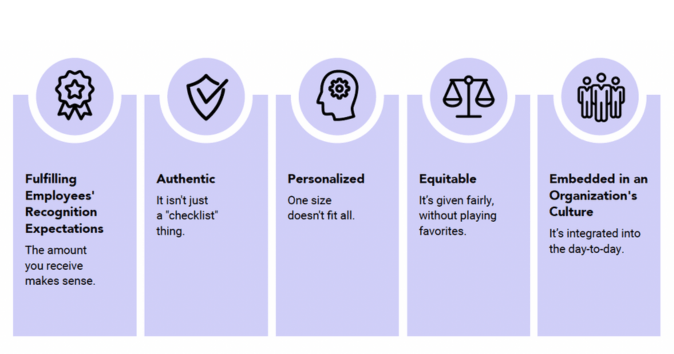Recognition Done Right: The Key to Employee Engagement & Retention

If you think employee engagement is improving with COVID-19 in the rearview mirror, think again.
Gallup research showsOpens in a new tab only 33% of employees in the U.S. and 23% of employees globally are engaged. What’s more, multiple reports have foundOpens in a new tab positive daily experiences for employees are near historic lows.
You read that right.
Fortunately, there’s an antidote to an issue that has long plagued the workplace: Employee recognition. Through the years, multiple studies have illustrated the correlation between recognition and employee engagement. But the benefits of recognition extend beyond engagement alone.
Gallup and Workhuman research has shown that a 10,000 person can save up to $16.1M in turnover costs annually by investing in recognition. Additional Gallup and Workhuman research shows recognition improves business outcomes through increased productivity, safer workplaces, and decreased absenteeism.
At Workhuman, we believe in the power of recognition done right. We’re the #1 provider of employee recognition software, with a 25-year track record of driving engagement, productivity, and retention for a deep, broad customer base comprised of many of the world’s most iconic, global companies.
Recognition done right means building a true “culture of recognition,” one where employees are empowered with the flexibility and authority to give and receive recognition frequently. But this type of meaningful, company-wide recognition doesn’t happen without the right investment to fuel widespread participation.
So, what level of recognition investment do you need to drive long-term impact? Let’s take a closer look:
The tipping point of recognition
Many organizations think of recognition as a “benefit” of total rewards, but it’s a tool to build culture and, in turn, drive measurable business outcomes.
As a gratitude-rich culture pervades an organization, companies begin to see an immediate and profound impact on employee engagement and productivity, as well as a marked reduction in absenteeism, leaves-of-absence, safety incidents, and voluntary attrition.
World at Work research article, '' showsOpens in a new tab organizations generally allocate 0.3% or less of the payroll budget to recognition – indicating that the majority of organizations are failing to capitalize on one of the most powerful tools at their disposal.
The failure to invest the right amount means companies aren’t unlocking the ultimate value of a recognition program.
As recognition investment increases, so too do business performance metrics like retention, engagement, and performance. Why? Because increasing the frequency of recognition means organizations see these types of incremental gains, compounding over time.
Workhuman iQ data modeling indicates recognition funding at 1% of payroll is the “sweet spot” for impacting each of these metrics. We call this the “tipping point of recognition” – where companies see the biggest impact of a recognition investment.
Through the years, we have found that customers who invest 1% of payroll in recognition realize outsized benefits.
Cisco has seen a 3X reduction in turnover with frequent recognition, funded at 1% of payroll. Even more impressive, the technology leader has experienced a 4.5X lower flight risk for employees tenured at one to three years who have robust recognition experiences.
FirstTech, whose recognition program is also funded at 1% of payroll, has found that employees who give recognition are 2X less likely to leave the organization than those who only receive recognition – and those who receive recognition are 2.5X less likely to leave than those who have never been recognized.
Need more convincing?
Let’s explore new evidence of recognition’s long-term impact:
The link between recognition and retention
Let’s reiterate where we started: Only 33% of employees in the U.S. and 23% of employees globally are engaged at work. Couple those statistics with yet another: In May 2024, Gallup foundOpens in a new tab that more than half (51%) of all U.S. employees were watching for or actively seeking a new job.
For organizations, this signals a five-alarm fire to proactively address an issue trending in the wrong direction. It goes without saying that the implications of turnover can be massive. To put a fine point on it, Gallup estimates that replacing:
- Leaders and managers costs around 200% of their salary
- Employees in technical roles costs 80% of their salary
- Frontline employees costs 40% of their salary
In new longitudinal research, Gallup and Workhuman evaluated the relationship between recognition and turnover by tracking the career paths of 3,447 employees from 2022 to 2024. The results are unequivocal:
Employees who receive high-quality recognition are less likely to leave their jobs. In fact, well-recognized employees were 45% less likely to have turned over two years later.
These longitudinal findings confirm the lasting impact of high-quality recognition. When embedded in an organization’s culture and delivered with intentionality and frequency, recognition affects real long-term behavior that has substantial implications for an organization’s future.
So, the quintessential question becomes: How can your organization put recognition into practice? Let’s look at what your organization needs to keep top of mind to engage and retain employees:
How to implement and embed recognition across your organization
The new research from Gallup and Workhuman reveals that senior leaders are giving increased attention to the power of recognition. In 2024, senior leaders were 50% more likely than they were in 2022 to strongly agree that the senior leaders at their organization value employee recognition.
However, leaders have yet to make real progress in implementing widespread practices that elevate the day-to-day recognition experiences of most employees.
To operationalize what great recognition looks like, Gallup and Workhuman have identified five essential pillars of strategic recognition in the workplace. Recognition is most impactful when it is fulfilling, authentic, personalized, equitable and embedded in company culture.

Starting with fulfilling just one pillar of strategic recognition can make a difference. Organizations that already have a robust culture of recognition can also vitalize it by incorporating additional elements of strategic recognition that have not yet taken hold.
For example, only 11% of employees surveyed by Gallup say someone in their current workplace has ever asked them how they like to be recognized for their accomplishments — the primary indicator for personalized recognition. Every manager and leader whose employees currently say “no” to this item could flip responses to “yes” with a simple inquiry about how employees like to be recognized.
The point is that simply caring about or valuing recognition is not enough. Research from Gallup and Workhuman confirms that when implemented with intention and backing from employees, strategic recognition can help facilitate drastic, long-lasting improvements in retention and employee engagement.
Final thoughts
Whether you’re already benefitting from recognition or you’re just starting out on your journey, it’s clear that recognition is a boon to the lives of employees – and the success of business. At Workhuman, we believe in recognition done right, which means building a culture of recognition that pervades every aspect of the organization.
About the author
Stacy Thompson
Stacy Thompson is senior director of content strategy & activation at Workhuman. A lover of language, Stacy focuses on bringing company stories to life from ideation to execution. A Midwestern native, Stacy lives in Billerica, MA with her husband, two kids, and two cats – and spends her time outside of work running, skiing, writing, reading, and yoga-ing.